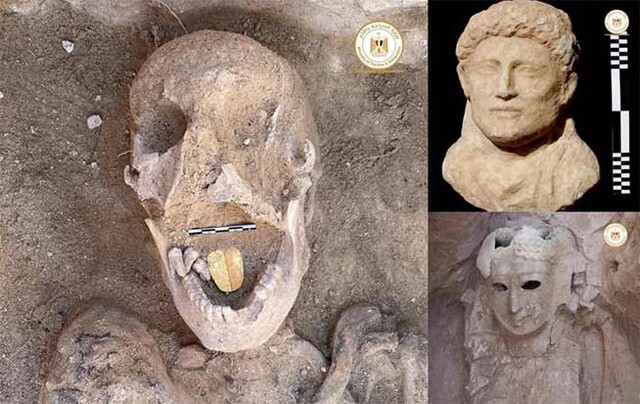During a recent expedition at an ancient Egyptian temple near Alexandria, archaeologists found something amazing and unique: a 2,000-year-old mummy with a golden tongue.
The mummy’s tongue is made of shiny gold. The discovery was made by a team of archaeologists from the Dominican Republic and Egypt, led by archaeologist Kathleen Martinez.
The excavation took place at a site known as Taposiris Magna, a small ancient community founded in 280 BC by Ptolemy II, one of the descendants of Alexander the Great, who ruled Ai Egypt as a Greek state for nearly 300 years.

The temple at Taposiris Magna containing mummies was dedicated to Osiris, Lord of the Underworld of Ancient Egypt, who was worshiped by the Greek leaders in Egypt.
Archaeologists don’t know for sure why the mummy had a golden tongue. Its discoverers theorized that the tongue was attached so that the deceased could verbally communicate with Osiris in the afterlife.

However, this is purely speculative, as there is no document that can identify individuals or prove that there could be anything to say that an ancient Egyptian god wanted to hear.
The mummy with the golden tongue is unusual, but it is just one of the fascinating relics found in 16 burial vaults recently discovered by Kathleen Martinez and the Dominica-Egypt team.
One of the more remarkable finds is a female mummy wrapped in a death mask.
Archaeologists also found the remains of two other buried mummies, one of which was covered with layers of plaster decorated with a gold image of Osiris. Partially intact scrolls have been found alongside these mummies, and archaeologists are now starting the process of deciphering the scrolls to see what secrets they might reveal.

In addition, several well-preserved statues were also discovered. These statues are believed to represent several important individuals buried in the temple of Taposiris Magna.
Other treasures discovered in the burial vault along with the mummies included eight marble masks and eight gold pieces that were once part of a golden wreath. It is not possible to date these relics to a specific year. But may have been buried with some certainty at some point during the period of Greek rule, which lasted from 305 BC to 30 BC.
Archaeologist Kathleen Martinez traveled to Egypt to begin her exploration in 2002, shortly after earning a master’s degree in archeology. She became interested in archeology and Ancient Egypt at the age of 15 when she became deeply obsessed with the life and times of the legendary Cleopatra.
When Martinez first went to Egypt, she did the search on her own and without the support of any organization. She came to search for the location of Cleopatra’s lost burial which is believed to not be found inside the mausoleum, but rather in a burial shaft in a temple dedicated to Osiris, who is presumably known. the most numerous of the ancient Egyptian gods.
It is known that Cleopatra and Mark Antony felt a bond with these figures in Egyptian mythology, and Martinez was certain that if she only found the right temple, she would find Cleopatra’s mummy.
During her first visit to Egypt, Martinez managed to get an appointment with Egypt’s Minister of Antiquities, Egyptologist Dr. Zahi Hawᴀss.
Faced with all the odds, Martinez applied for a two-month permit to explore some of the temples that aren’t normally open to independent researchers. Despite having a brief search, Martinez made a fateful discovery that changed her life.
“In archeology, two months is nothing. But I took what they gave me, and on the last day of those two months I made a great discovery that changed the architecture of the temples of Ai. Egypt. I found two rooms that were previously hidden in the Taposiris Magna temple where Cleopatra and Mark Antony may have been,” Martinez said.
Returning home to the Dominican Republic, Martinez persuaded officials at the University of Santo Domingo to fund further archaeological work at Taposiris Magna. In 2005, Martinez and her team became the first archaeologists from Latin America to be allowed to conduct excavations on Egyptian soil.
It remains to be seen whether Martinez will ever find Cleopatra’s burial place. Although scholars do not dismiss the possibility that the legendary queen and Mark Antony may have been buried alive in the temple at Taposiris Magna, there is no actual evidence to suggest so. Many archaeologists and Egyptologists strongly doubt Martinez’s theory, including Dr. Hawᴀss.
But there’s no denying what Martinez and his team have discovered as they have discovered hundreds of artifacts since excavations began in 2005, including a bust of Queen Cleopatra and some ancient coins. from her time. They also discovered evidence proving that the foundation of the temple was built under the authority of Ptolemy IV, who ruled Egypt from 221 BC to 204 BC.





